brakes CHEVROLET CAMARO 1996 4.G Owner's Manual
[x] Cancel search | Manufacturer: CHEVROLET, Model Year: 1996, Model line: CAMARO, Model: CHEVROLET CAMARO 1996 4.GPages: 402, PDF Size: 21.38 MB
Page 203 of 402
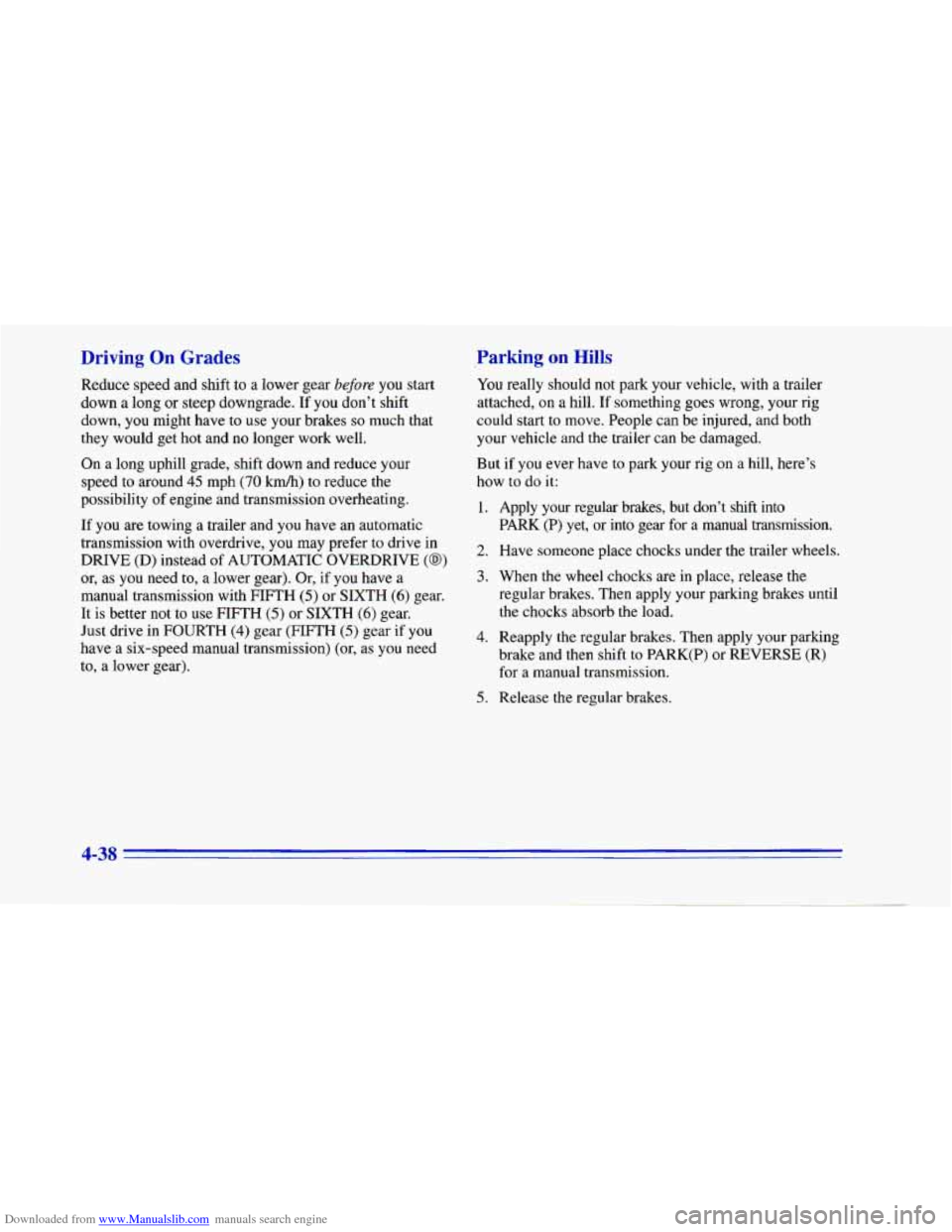
Downloaded from www.Manualslib.com manuals search engine Driving On Grades
Reduce speed and shift to a lower gear before you start
down a long or steep downgrade. If you don’t shift
down, you might have to use your brakes
so much that
they would get hot and no longer work well.
On a long uphill grade, shift down and reduce your
speed to around
45 mph (70 km/h) to reduce the
possibility
of engine and transmission overheating.
If you are towing a trailer and you have an automatic
transmission with overdrive,
you may prefer to drive in
DRIVE (D) instead of AUTOMATIC OVERDRIVE (@)
or, as you need to, a lower gear). Or, if you have a
manual transmission with FIFTH
(5) or SIXTH (6) gear.
It
is better not to use FIFTH (5) or SIXTH (6) gear.
Just drive in FOURTH
(4) gear (FIFTH (5) gear if you
have a six-speed manual transmission) (or, as you need
to, a lower gear).
Parking on Hills
You really should not park your vehicle, with a trailer
attached, on a hill.
If something goes wrong, your rig
could start to move. People can be injured, and both
your vehicle and the trailer can be damaged.
But if you ever have
to park your rig on a hill, here’s
how to
do it:
1.
2.
3.
4.
5.
Apply your regular brakes, but don’t shift into
PARK
(P) yet, or into gear for a manual transmission.
Have someone place chocks under the trailer wheels.
When the wheel chocks are in place, release the
regular brakes. Then apply your parking brakes until
the chocks absorb the load.
Reapply the regular brakes. Then apply your parking
brake and then shift to PARK(P) or REVERSE
(R)
for a manual transmission.
Release the regular brakes.
4-38
Page 204 of 402
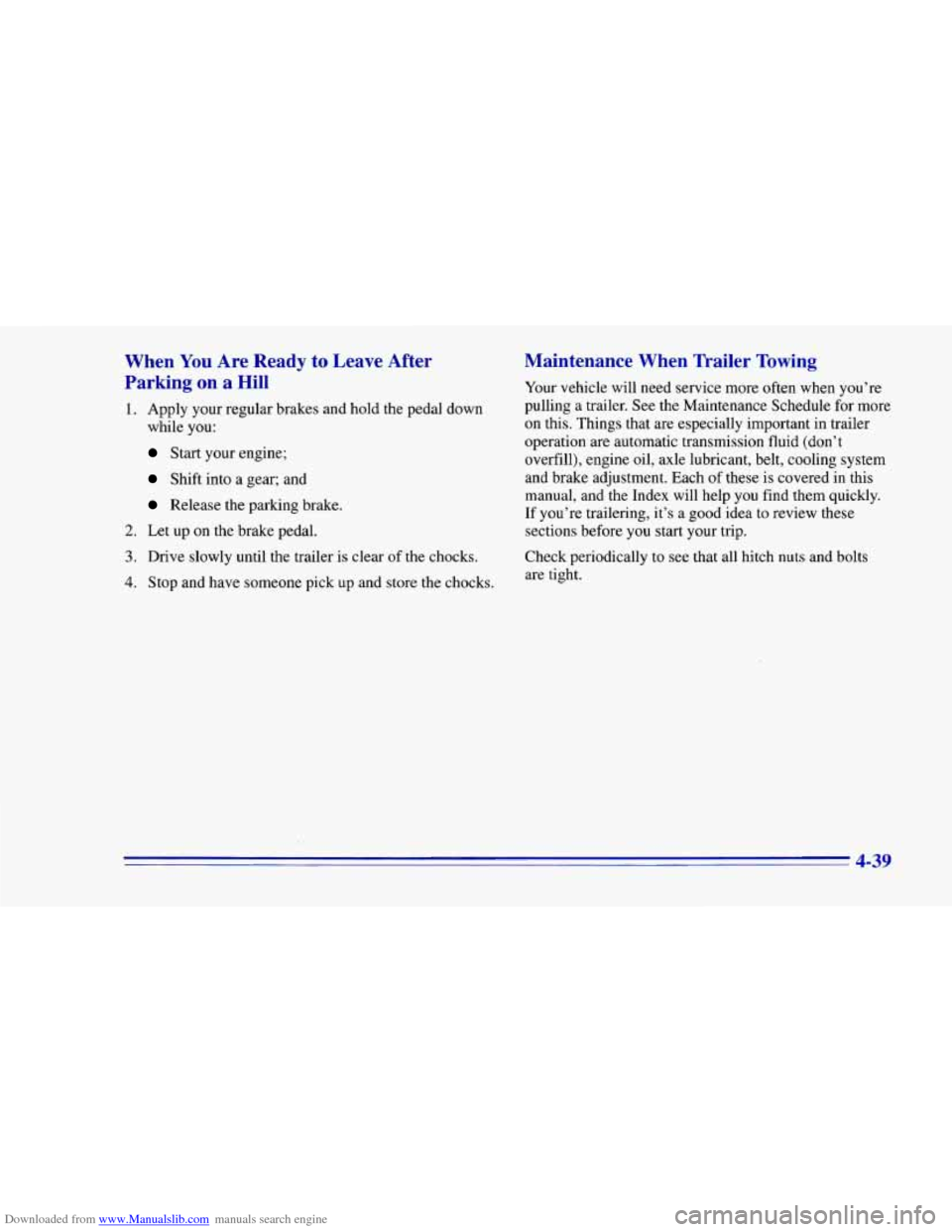
Downloaded from www.Manualslib.com manuals search engine When You Are Ready to Leave After
Parking on a Hill
1. Apply your regular brakes and hold the pedal down
while you:
Start your engine;
Shift into a gear; and
Release the parking brake.
2. Let up on the brake pedal.
3. Drive slowly until the trailer is clear of the chocks.
4. Stop and have someone pick up and store the chocks.
Maintenance When Trailer Towing
Your vehicle will need service more often when you’re
pulling a trailer. See the Maintenance Schedule for more
on this. Things that are especially important in trailer
operation are automatic transmission fluid (don’t
overfill), engine oil, axle lubricant, belt, cooling system
and brake adjustment. Each
of these is covered in this
manual, and the Index will help
you find them quickly.
If you’re trailering, it’s a good idea to review these
sections before you start your trip.
Check periodically to see that all hitch nuts and bolts
are tight.
4-39
Page 284 of 402
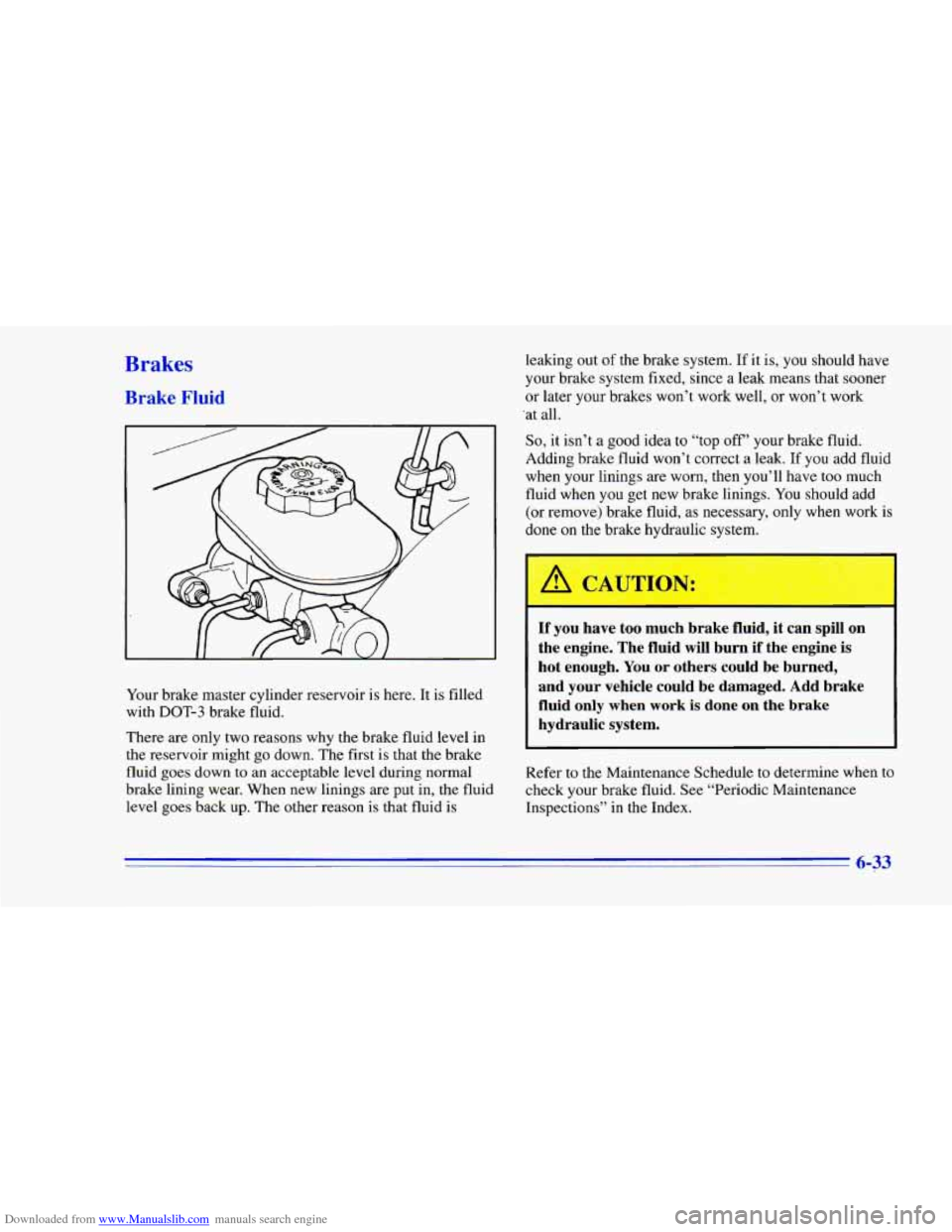
Downloaded from www.Manualslib.com manuals search engine Brakes
Brake Fluid
Your brake master cylinder reservoir is here. It is filled
with
DOT-3 brake fluid.
There
are only two reasons why the brake fluid level in
the reservoir might go down. The first is that the brake
fluid goes down
to an acceptable level during normal
brake lining wear. When new linings are put in, the fluid
level goes back up. The other reason is that fluid
is
leaking out of the brake system. If it is, you should have
your brake system fixed, since
a leak means that sooner
or later your brakes won’t work well, or won’t work
‘at
all.
So, it isn’t a good idea to “top off’ your brake fluid.
Adding brake fluid won’t correct a leak. If you add fluid
when your linings
are worn, then you’ll have too much
fluid when
you get new brake linings. You should add
(or remove) brake fluid, as necessary, only when work is
done
on the brake hydraulic system.
If you have too much brake fluid, it can spill on
the engine. The fluid will burn if the engine is
hot enough. You or others could be burned,
and your vehicle could be damaged.
Add brake
fluid only
when work is done on the brake
hydraulic system.
Refer to the Maintenance Schedule to determine when to
check your brake fluid. See “Periodic Maintenance
Inspections’’ in the Index.
6-33
Page 285 of 402
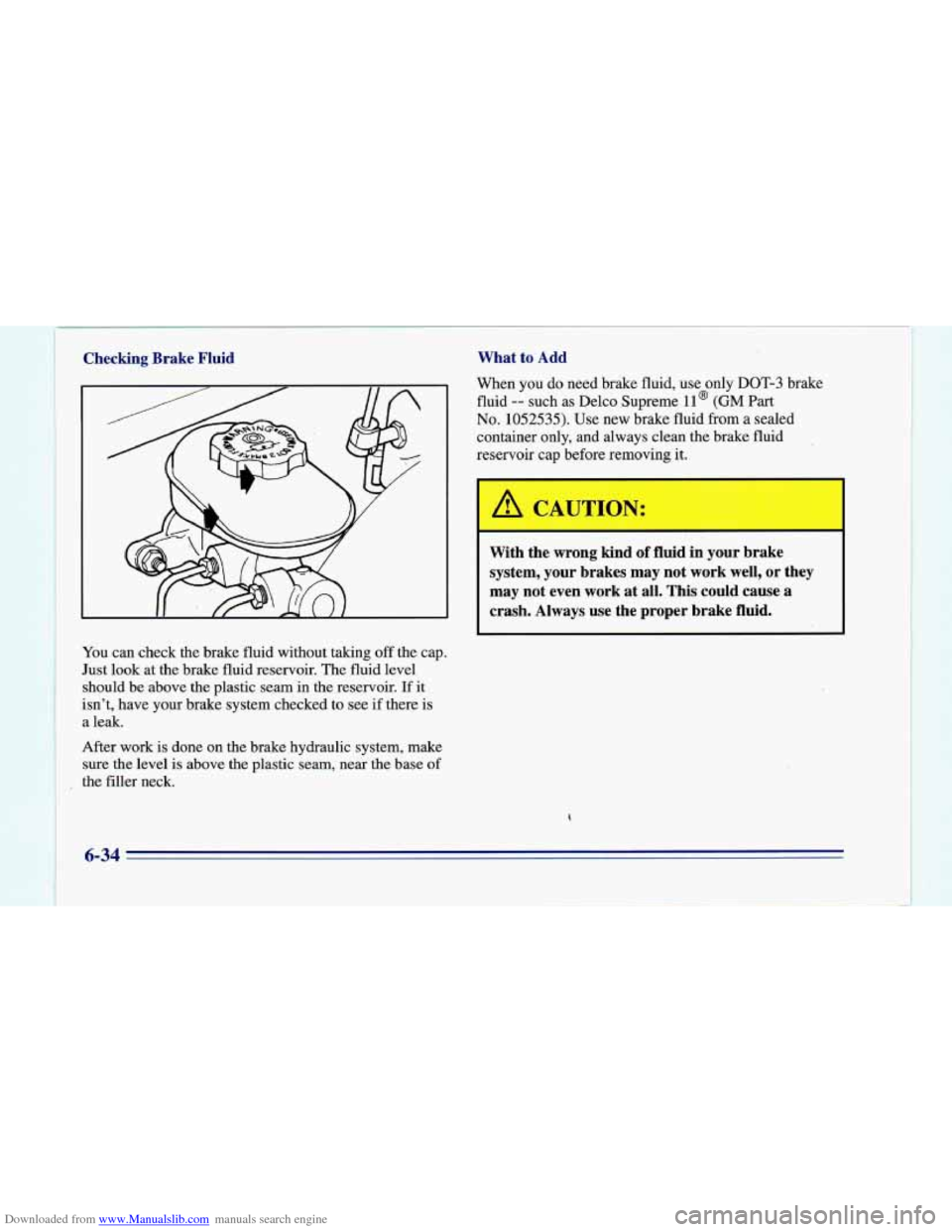
Downloaded from www.Manualslib.com manuals search engine Checking Brake Fluid
You can check the brake fluid without taking off the cap.
Just look at the brake fluid reservoir. The fluid level
should be above the plastic seam in the reservoir. If it
isn't, have your brake system checked
to see if there is
a leak.
What to Add
When you do need brake fluid, use only DOT-3 brake
fluid
-- such as Delco Supreme 11 @ (GM Part
No. 1052535). Use new brake fluid from a sealed
container only, and always clean the brake fluid
reservoir cap before removing it.
cAU' 1u
With the wrong kind of fluid in your brake
system, your brakes may not work well, or they
may not even work at all. This could cause
a
crash. Always use the proper brake fluid.
After work is done on the brake hydraulic system, make
sure the level is above the plastic seam, near the base of
, the filler neck.
6-34
Page 286 of 402
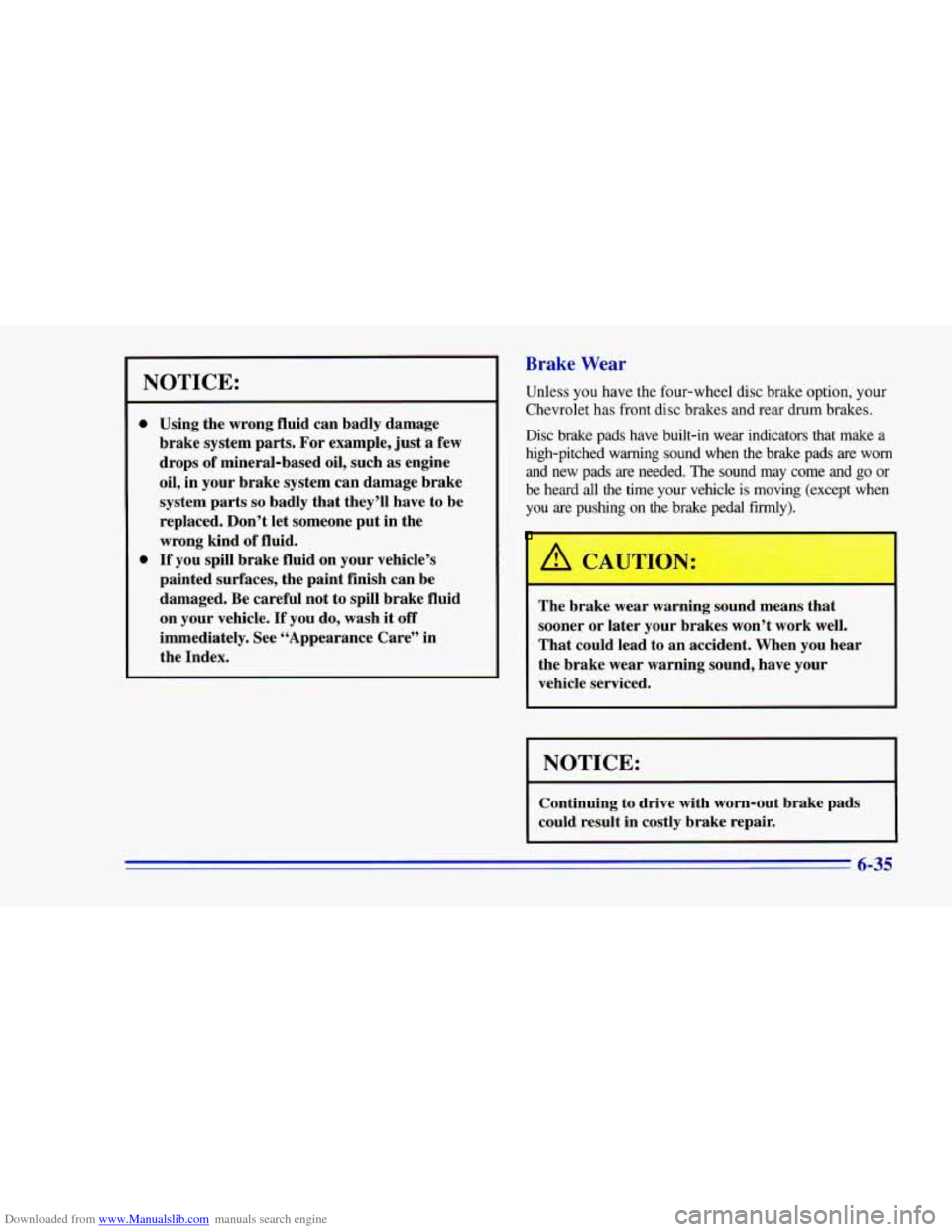
Downloaded from www.Manualslib.com manuals search engine Brake Wear
NOTICE:
0
0
Using the wrong fluid can badly damage
brake system parts. For example, just a few
drops of mineral-based oil, such as engine
oil, in your brake system can damage brake
system parts
so badly that they’ll have to be
replaced. Don’t let someone put in the
wrong kind
of fluid.
If you spill brake fluid on your vehicle’s
painted surfaces, the paint finish can be
damaged. Be careful not to spill brake fluid
on your vehicle.
If you do, wash it off
immediately. See “Appearance Care” in
the Index.
Unless you have the four-wheel disc brake option, your
Chevrolet has front disc brakes and rear drum brakes.
Disc brake pads have built-in wear indicators that make
a
high-pitched warning sound when the brake pads are worn
and new pads are needed. The sound may come and go or
be heard all the time your vehicle is moving (except when
you are pushing
o he brake pedal firmly).
The brake wear warning sound means that
sooner or later your brakes won’t work well.
That could lead to an accident. When you hear
the brake wear warning sound, have your
vehicle serviced.
I NOTICE:
Continuing to drive with worn-out brake pads
could result in costly brake repair.
6-35
Page 287 of 402
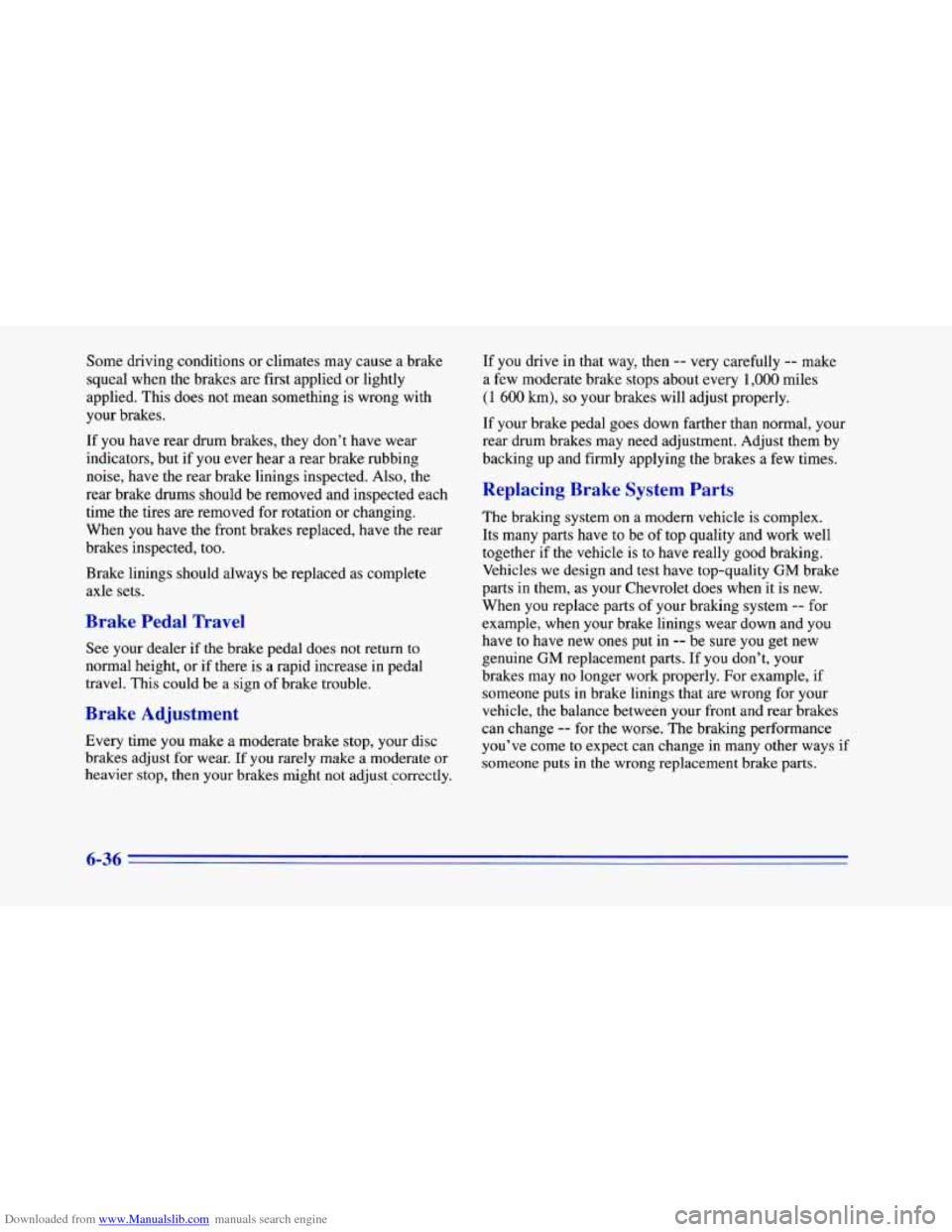
Downloaded from www.Manualslib.com manuals search engine Some driving conditions or climates may cause a brake
squeal when the brakes are first applied or lightly
applied. This does not
mean something is wrong with
your brakes.
If
you have rear drum brakes, they don’t have wear
indicators, but if you ever hear
a rear brake rubbing
noise, have the rear brake linings inspected. Also, the
rear brake drums should be removed and inspected each
time the tires are removed for rotation or changing.
When
you have the front brakes replaced, have the rear
brakes inspected, too.
Brake linings should always be replaced as complete
axle sets.
Brake Pedal Travel
See your dealer if the brake pedal does not return to
normal height, or if there is a rapid increase in pedal
travel, This could be a sign of brake trouble.
Brake Adjustment
Every time you make a moderate brake stop, your disc
brakes adjust for wear. If you rarely make a moderate or
heavier stop, then your brakes might not adjust correctly. If you
drive in that way, then
-- very carefully -- make
a few moderate brake stops about every
1,000 miles
(1
600 km), so your brakes will adjust properly.
If your brake pedal goes down farther than normal, your
rear drum brakes may need adjustment. Adjust them by
backing up and firmly applying the brakes a few times.
Replacing Brake System Parts
The braking system on a modern vehicle is complex.
Its many parts have
to be of top quality and work well
together if the vehicle is to have really good braking.
Vehicles we design and test have top-quality
GM brake --
parts in them, as your Chevrolet does when it is new.
When
you replace parts of your braking system -- for
example, when your brake linings wear down and
you
have to have new ones put in -- be sure you get new
genuine
GM replacement parts. If you don’t, your
brakes may no longer work properly. For example, if
someone puts
in brake linings that are wrong for your
vehicle, the balance between your front and rear brakes
can change
-- for the worse. The braking performance
you’ve come
to expect can change in many other ways
someone puts in the wrong replacement brake parts. if
6-36
Page 369 of 402
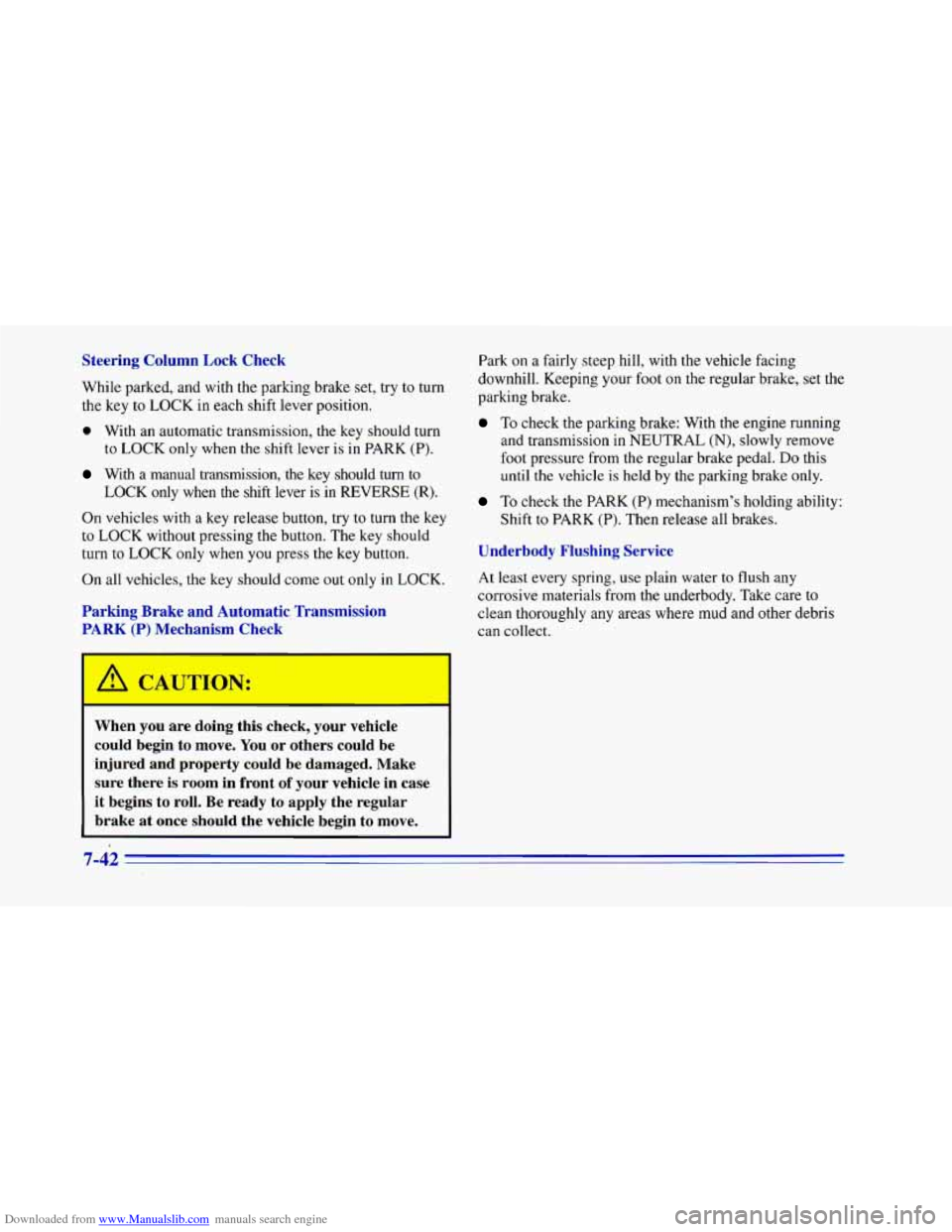
Downloaded from www.Manualslib.com manuals search engine Steering Column Lock Check
While parked, and with the parking brake set, try to turn
the key
to LOCK in each shift lever position.
0 With an automatic transmission, the key should turn
to LOCK only when the shift lever is in PARK (P).
With a manual transmission, the key should turn to
LOCK only when the shift lever is in REVERSE (R).
On vehicles with
a key release button, try to turn the key
to LOCK without pressing the button. The key should
turn to LOCK only when you press the key button.
On all vehicles, the key should come out only
in LOCK.
Parking Brake and Automatic. Transmission
PARK (P) Mechanism Check
Park on a fairly steep hill, with the vehicle facing
downhill. Keeping your foot on the regular brake, set the
parking brake.
To check the parking brake: With the engine running
and transmission in NEUTRAL (N), slowly remove
foot pressure from
the regular brake pedal. Do this
until
the vehicle is held by the parking brake only.
To check the PARK (P) mechanism’s holding ability:
Shift
to PARK (P). Then release all brakes.
Underbody FI ~ -3g Service
At least every spring, use plain water to flush any
corrosive materials from the underbody. Take care to
clean thoroughly any areas where mud and other debris
can collect.
When you are doing this check, your vehicle
could begin
to move. You or others could be
injured and property could be damaged. Make
sure there
is room in front of your vehicle in case
it begins to roll. Be ready to apply the regular
brake at once should the vehicle begin to move.
7-42
Page 370 of 402
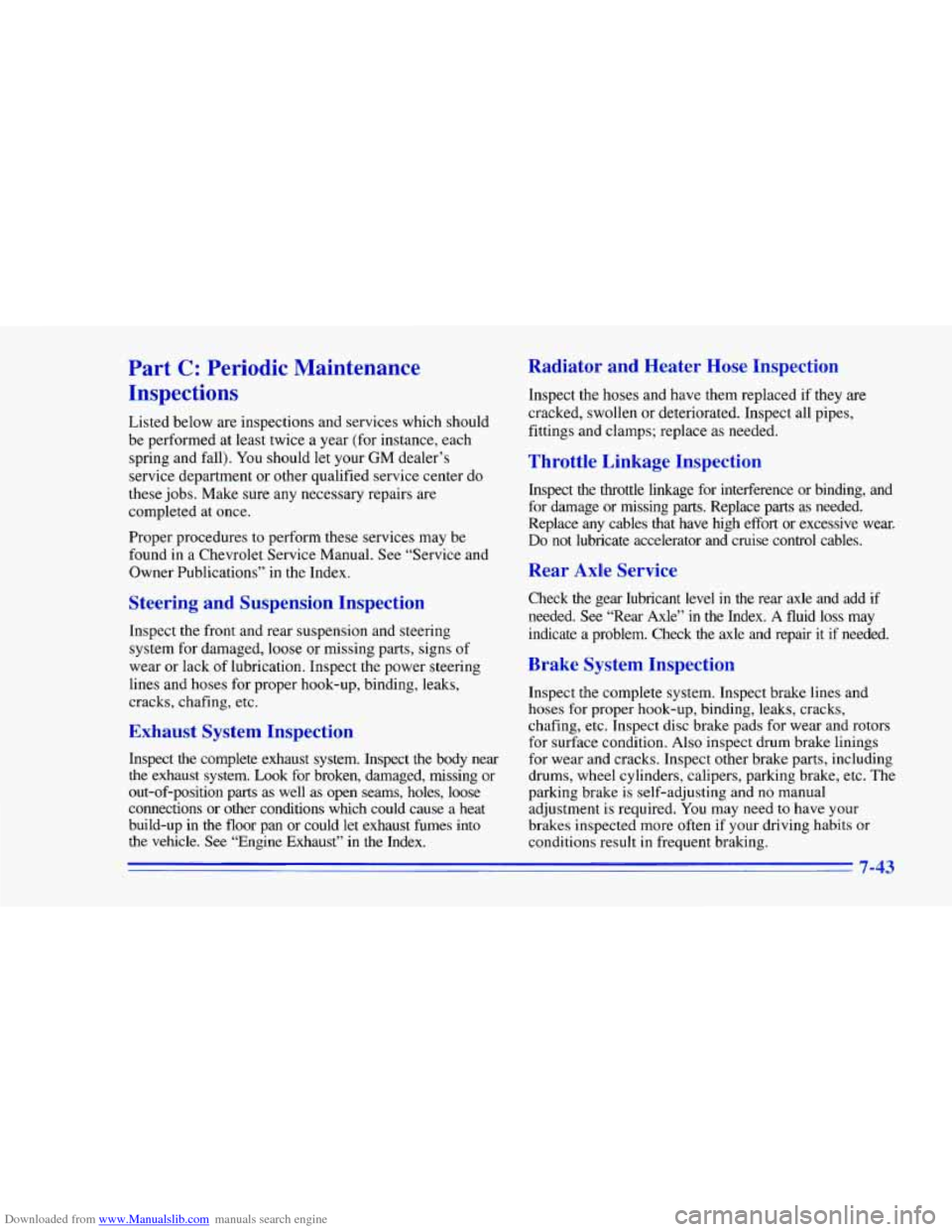
Downloaded from www.Manualslib.com manuals search engine Part C: Periodic Maintenance
Inspections
Listed below are inspections and services which should
be performed at least twice a year (for instance, each
spring and fall). You should let your
GM dealer’s
service department or other qualified service center do
these jobs. Make sure any necessary repairs are
completed at once.
Proper procedures to perform these services may be
found in a Chevrolet Service Manual. See “Service and
Owner Publications” in the Index.
Steering and Suspension Inspection
Inspect the front and rear suspension and steering
system for damaged, loose or missing parts, signs of
wear or lack of lubrication. Inspect the power steering
lines and hoses for proper hook-up, binding, leaks,
cracks, chafing, etc.
Exhaust System Inspection
Inspect the complete exhaust system. Inspect the body near
the exhaust system. Look for broken, damaged, missing or
out-of-position
parts as well as open seams, holes, loose
connections
or other conditions which could cause a heat
build-up in the floor
pan or could let exhaust fumes into
the vehicle.
See “Engine Exhaust” in the Index,
Radiator and Heater Hose Inspection
Inspect the hoses and have them replaced if they are
cracked, swollen or deteriorated. Inspect all pipes,
fittings and clamps; replace as needed.
Throttle Linkage Inspection
Inspect the throttle linkage for interference or binding, and
for damage or missing parts. Replace parts as needed.
Replace
any cables that have high effort or excessive wear.
Do not lubricate accelerator and cruise control c.ables.
Rear Axle Service
Check the gear lubricant level in the rear axle and add if
needed. See “Rear Axle” in the Index. A fluid loss may
indicate a problem. Check the axle and repair it if needed.
Brake System Inspection
Inspect the complete system. Inspect brake lines and
hoses for proper hook-up, binding, leaks, cracks,
chafing, etc. Inspect disc brake pads for wear and rotors
for surface condition. Also inspect drum brake linings
for wear and cracks. Inspect other brake parts, including
drums, wheel cylinders, calipers, parking brake, etc. The
parking brake is self-adjusting and no manual
adjustment is required. You may need
to have your
brakes inspected
more often if your driving habits or
conditions result in frequent braking.
7-43
Page 390 of 402
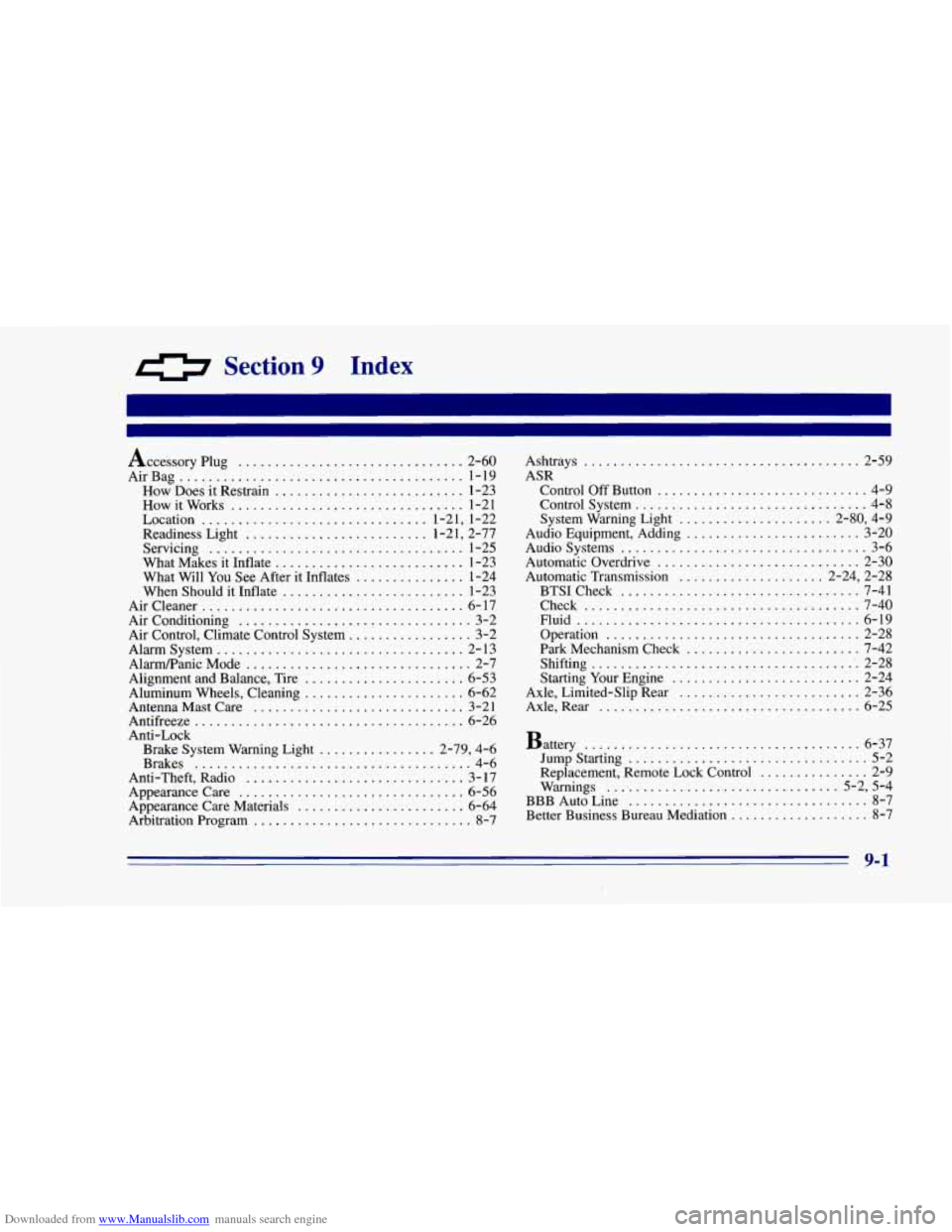
Downloaded from www.Manualslib.com manuals search engine 0 Section 9 Index
Accessory Plug ............................... 2-60
AirBag
....................................... 1-19
How Does it Restrain
.......................... 1-23
Howitworks
................................ 1-21
Location
............................... 1.21. 1-22
Readiness Light
......................... 1.21. 2.77
Servicing
................................... 1-25
What Makes it Inflate
.......................... 1-23
What Will You See After it Inflates
............... 1-24
When Should it Inflate
......................... 1-23
Aircleaner
.................................... 6-17
Air Conditioning
................................ 3-2
Air Control. Climate Control System
................. 3-2
Alarmsystem
.................................. 2-13
AlarmPanicMode
............................... 2-7
Alignment and Balance. Tire
...................... 6-53
Aluminum Wheels. Cleaning
...................... 6-62
Antenna Mast Care
............................. 3-21
Antifreeze
..................................... 6-26
Anti-Lock
Brake System Warning Light
................ 2.79. 4.6
Brakes
....................................... 4-6
Anti.Theft. Radio
.............................. 3- 17
Appearancecare
............................... 6-56
Appearance Care Materials
....................... 6-64
Arbitration Program
.............................. 8-7
Ashtrays ...................................... 2-59
ASR Control Off Button
............................. 4-9
Control System
................................ 4-8
System Warning Light
..................... 2.80. 4.9
Audio Equipment. Adding
........................ 3-20
Audio Systems
.................................. 3-6
Automatic Overdrive
............................ 2-30
Automatic Transmission
.................... 2.24. 2.28
BTSICheck
................................. 7-41
Check
...................................... 7-40
Fluid
....................................... 6-19
Operation
................................... 2-28
Park Mechanism Check
........................ 7-42
Shifting
...................................... 2-28
Starting Your Engine
.......................... 2-24
Axle. Limited-Slip Rear
......................... 2-36
Axle. Rear
.................................... 6-25
Battery ...................................... 6-37
Jump Starting
................................. 5-2
Replacement. Remote Lock Control
............... 2-9
Warnings
................................ 5.2. 5.4
BBB Auto Line
................................. 8-7
Better Business Bureau Mediation
................... 8-7
9-1
Page 391 of 402
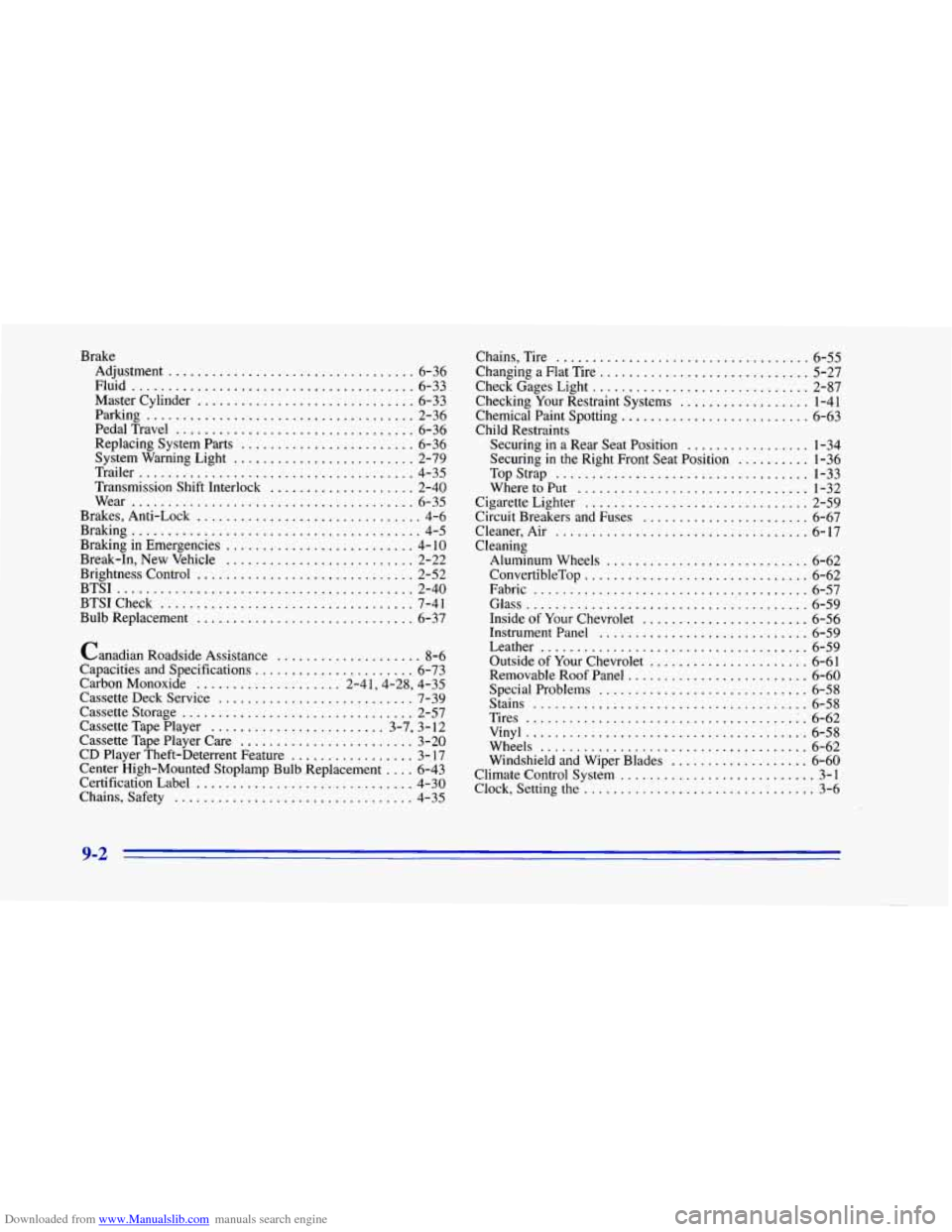
Downloaded from www.Manualslib.com manuals search engine Brake Adjustment
.................................. 6-36
Fluid
....................................... 6-33
Master Cylinder
.............................. 6-33
Parking
..................................... 2-36
PedalTravel
................................. 6-36
Replacing System Parts
........................ 6-36
System Warning Light
......................... 2-79
Trailer
...................................... 4-35
Transmission Shift Interlock
.................... 2-40
Wear
....................................... 6-35
Brakes, Anti-Lock
............................... 4-6
Braking
........................................ 4- 5
Braking
in Emergencies .......................... 4- 10
Break-In, New Vehicle
.......................... 2-22
Brightness Control
.............................. 2-52
BTSI
......................................... 2-40
BTSICheck
................................... 7-41
Bulb Replacement
.............................. 6-37
Canadian Roadside Assistance
.................... 8-6
Carbon Monoxide
.................... 2.41.4.28. 4.35
Cassette Deck Service
........................... 7-39
Capacities
and Specifications
...................... 6-73
Cassette Storage
................................ 2-57
Cassette Tape Player
........................ 3.7. 3. 12
Cassette Tape Player Care ........................ 3-20
CD Player Theft-Deterrent Feature
................. 3- 17
Center High-Mounted Stoplamp Bulb Replacement
.... 6-43
Certification Label
.............................. 4-30
Chains. Safety
................................. 4-35 Chains. Tire
................................... 6-55
Changing
a Flat Tire ............................. 5-27
Check Gages Light
.............................. 2-87
Checking Your Restraint Systems
.................. 1-41
Chemical Paint Spotting
.......................... 6-63
Securing
in a Rear Seat Position ................. 1-34
Child Restraints
Securing
in the Right Front Seat Position .......... 1-36
TopStrap
................................... 1-33
WheretoPut
................................ 1-32
Cigarette Lighter
............................... 2-59
Circuit Breakers and Fuses
....................... 6-67
Cleaner.Air
................................... 6-17
Cleaning Aluminum Wheels
............................ 6-62
ConvertibleTop
............................... 6-62
Fabric
...................................... 6-57
Glass
....................................... 6-59
Inside
of Your Chevrolet ....................... 6-56
Instrument Panel
............................. 6-59
Leather
..................................... 6-59
Outside
of Your Chevrolet ...................... 6-61
Removable Roof Panel
......................... 6-60
Stains
...................................... 6-58
Tires
....................................... 6-62
Wheels
..................................... 6-62
Special Problems
............................. 6-58
Vinyl ....................................... 6-58
Windshield and Wiper Blades
................... 6-60
Climate Control System
........................... 3-1
Clock. Setting the
................................ 3-6
9-2